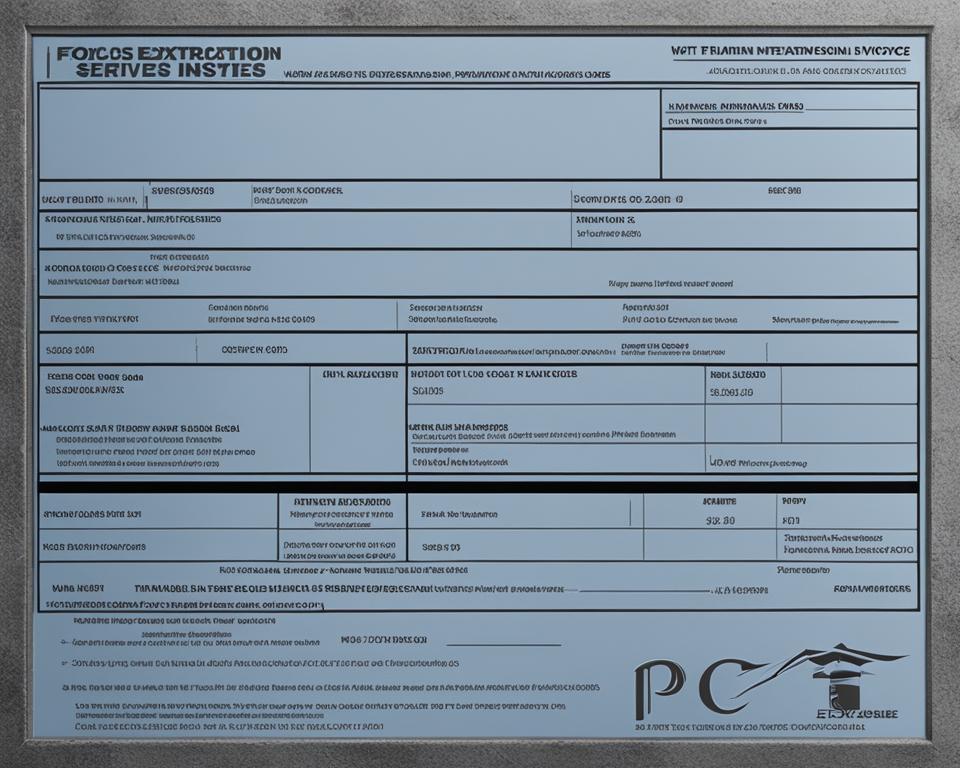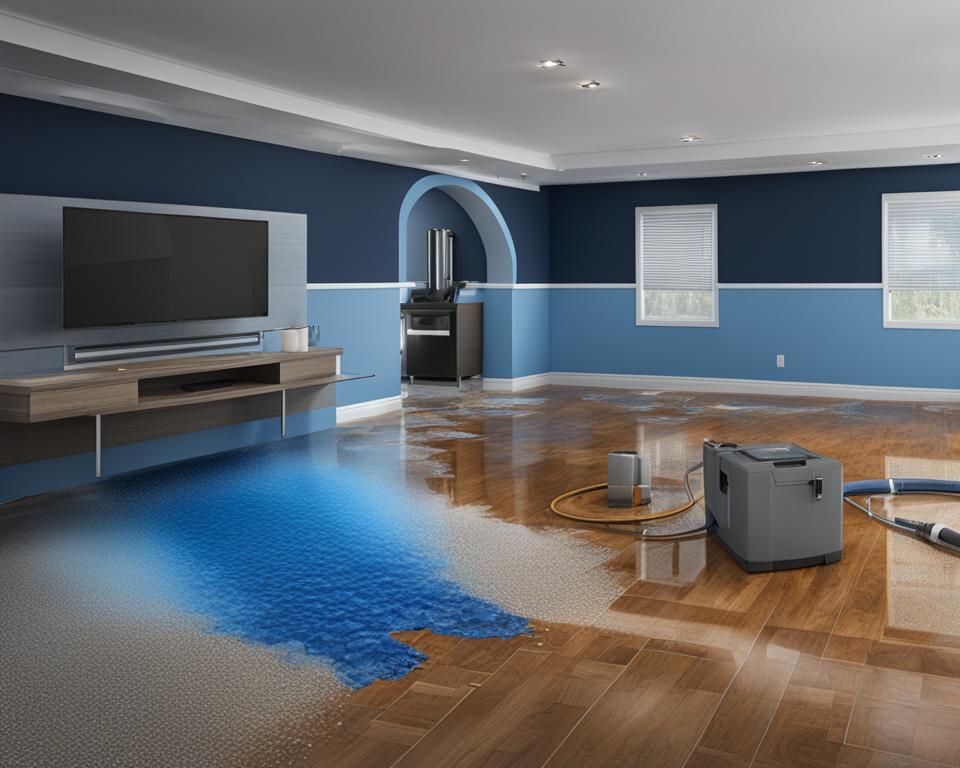When faced with water damage, professional water extraction is often necessary to restore your property and prevent further issues. However, it’s essential to understand the cost associated with this service to plan effectively and make informed decisions.
The average cost of water damage restoration ranges from $1,300 to $5,600. This cost can vary based on several factors, such as the type of water damage, the extent of the damage, and the location of the affected areas.
There are three categories of water damage: clean water, gray water, and black water. Repairing clean water damage typically costs between $3 to $4 per square foot, while gray water damage costs $4 to $7 per square foot. Black water damage, which involves sewage or groundwater contamination, is the most expensive to repair, with an average cost of $7 to $7.50 per square foot. Additionally, the class of water damage, with class 1 being the least expensive and class 4 being the most expensive, can also impact the overall cost. Labor, emergency callouts, and geographic location may further influence the final price of professional water extraction.
Key Takeaways:
- The cost of professional water extraction can range from $1,300 to $5,600.
- The type and extent of water damage affect the overall cost.
- Clean water damage repairs cost around $3 to $4 per square foot, while gray water damage repairs cost $4 to $7 per square foot.
- Black water damage, which involves sewage or groundwater contamination, is the most expensive to repair, with costs averaging $7 to $7.50 per square foot.
- The class of water damage, ranging from class 1 to class 4, also influences the cost of restoration.
Factors Affecting Water Extraction Cost
When it comes to professional water extraction, several factors can influence the cost of the service. Understanding these factors can help homeowners anticipate the expenses and make informed decisions. Here are the key factors that affect the cost of water extraction:
Type of Water Damage
The type of water damage plays a significant role in determining the cost of extraction. Clean water damage, which comes from a clean water source such as a burst pipe, is generally less expensive to repair compared to gray water or black water damage. Gray water, which may contain contaminants from appliances or toilets, requires additional precautions and can increase the cost. Black water, which contains sewage or other hazardous substances, involves extensive cleanup and restoration, making it the most expensive type of water damage to address.
Extent and Location of Damage
The size and location of the water damage can also impact the cost of extraction. Larger areas that have been affected or structural damage that requires additional repairs will naturally incur higher expenses. For example, water damage in multiple rooms or damage that has spread to the foundation of the house may require more extensive restoration work, driving up the overall cost.
Labor and Emergency Callout Fees
The cost of professional water extraction includes labor charges, which can vary based on the severity of the damage and the number of hours required to complete the restoration. Additionally, emergency callout fees may apply if the extraction service is needed outside of regular business hours or during emergency situations like flooding or pipe bursts. These fees can contribute to the overall cost of water extraction.
Geographic Location
The geographic location of the property can also impact the cost of water extraction. In rural areas with limited competition, the prices may be higher due to fewer available restoration companies. Conversely, in urban areas with more restoration companies, the cost may be lower due to higher levels of competition. Therefore, the location of the property can influence the affordability of water extraction services.
Understanding these factors can help homeowners better estimate the cost of professional water extraction. By considering the type of water damage, the extent of the damage, labor and emergency callout fees, and the geographic location, homeowners can make informed decisions and find affordable water extraction services that meet their needs.
Types of Water Damage
Water damage can occur in various forms, and understanding the different types can help homeowners estimate the cost of water extraction and restoration. The three main types of water damage are clean water, gray water, and black water. Each type requires different levels of mitigation and restoration, impacting the overall cost of the process.
Clean Water Damage
Clean water damage refers to water that comes from a clean source, such as a burst pipe or a leaking faucet. This type of damage is considered the least severe and easiest to mitigate and repair. The average cost of water extraction for clean water damage ranges from $3 to $4 per square foot.
Gray Water Damage
Gray water damage occurs when water has come into contact with potentially harmful substances, such as water from a dishwasher or washing machine leak. This type of damage requires more extensive mitigation and restoration compared to clean water damage. The average cost of water extraction for gray water damage ranges from $4 to $7 per square foot.
Black Water Damage
Black water damage is the most severe type of water damage and involves water that is heavily contaminated with sewage, chemicals, or natural disasters like floods. Mitigating and restoring black water damage requires specialized equipment and expertise. The average cost of water extraction for black water damage ranges from $7 to $7.50 per square foot.
These cost estimates are general guidelines and can vary depending on the size of the affected area and the extent of the damage. It is important to consult a professional water damage restoration company for a more accurate cost estimate based on the specific circumstances of the water damage.

Classes of Water Damage
Water damage is classified into four classes, ranging from class 1 to class 4. Each class represents a different level of severity and difficulty in the clean-up process. Understanding the classes of water damage can help homeowners assess the extent of the damage and determine the appropriate steps for restoration.
It is important to note that while class 1 and class 2 damage can sometimes be addressed by homeowners themselves, class 3 and class 4 damage typically require professional assistance due to the complexity and potential risks involved.
Class 1
Class 1 water damage is the least severe and involves small amounts of water that have only affected a limited area. This could be a small portion of a room or an isolated area. The clean-up process for class 1 damage usually involves extraction of the water and drying out the affected area. The cost of clean-up for class 1 damage is generally lower compared to other classes.
Class 2
Class 2 water damage is characterized by a larger area of water intrusion, typically affecting an entire room or multiple rooms. The water may have soaked into carpets, walls, and furniture. The clean-up process for class 2 damage involves thorough extraction, drying, and potentially removing and replacing damaged materials. The cost of clean-up for class 2 damage is higher compared to class 1.
Class 3
Class 3 water damage is more severe, involving significant water saturation of walls, ceilings, and floors. The water may have come from overhead, such as a burst pipe or a roof leak. Class 3 damage often requires extensive extraction, drying, removal of damaged materials, and structural repairs. The cost of clean-up for class 3 damage is considerably higher than class 1 and class 2.
Class 4
Class 4 water damage is the most severe and difficult to clean up. It involves deep water saturation and affects not only the structural elements but also materials like concrete and hardwood. Class 4 damage is typically caused by factors such as flooding or prolonged exposure to water. The clean-up process for class 4 damage can be extensive, requiring specialized equipment and techniques. The cost for clean-up of class 4 damage is the highest among the classes.
| Class of Water Damage | Description |
|---|---|
| Class 1 | Small amount of water, limited area affected |
| Class 2 | Larger area affected, potential damage to carpets and furniture |
| Class 3 | Significant saturation of walls, ceilings, and floors |
| Class 4 | Deep water saturation, extensive damage to structural elements |
Common Areas Impacted by Water Damage
Water damage can wreak havoc on various areas of a home, leading to expensive repairs and restoration. Here are some common areas that are frequently affected by water damage:
Floors
Water can seep into flooring materials, causing warping, buckling, or discoloration. The cost of repairing water-damaged floors depends on the type of flooring, with hardwood and carpet generally being more expensive to restore compared to tile or laminate.
Walls and Drywall
When water infiltrates walls and drywall, it can lead to mold growth, peeling paint, and structural damage. Repairing water-damaged walls may involve patching or replacing affected areas, as well as addressing any underlying moisture issues.
Ceiling
Water damage to ceilings can result from roof leaks, plumbing issues, or burst pipes. It can cause stains, sagging, and even ceiling collapse in severe cases. Repairing a water-damaged ceiling often involves removing the affected materials, repairing the source of the water damage, and restoring the ceiling’s structural integrity.
| Area | Average Cost of Repair |
|---|---|
| Floors | $200 – $550 for hardwood flooring |
| $1.50 – $3.00 per square foot for tile or laminate | |
| Walls and Drywall | $1.50 – $3.00 per square foot |
| Ceiling | $350 – $1,250 |
It’s important to address water damage in these areas promptly to prevent further deterioration and potential health hazards. Hiring a professional water damage restoration company can ensure the proper assessment, mitigation, and repairs are conducted, helping homeowners minimize costs and restore their homes to safe and habitable conditions.
Factors Affecting Water Damage Restoration Cost
When it comes to water damage restoration, several factors can influence the overall cost of the project. It’s important to understand these factors to accurately assess the financial implications of water damage and plan for the necessary restoration work. The main factors that can affect the cost of water damage restoration include labor costs, emergency callouts, and geographic location.
Labor Costs
Labor costs can have a significant impact on the overall cost of water damage restoration. The severity of the damage and the number of hours required for the restoration work will directly affect the labor expenses. In cases where extensive restoration is needed, such as in the aftermath of a major flood, the labor costs can be higher. It’s crucial to have a clear understanding of the expected labor costs before proceeding with the restoration project.
Emergency Callouts
In situations where water damage is sudden and unexpected, emergency callouts may be necessary. These callouts often occur during flooding or as a result of burst pipes. Emergency callouts can incur higher fees due to the immediate response and the need to address the water damage promptly. It’s important to consider the potential cost of emergency callouts when budgeting for water damage restoration.
Geographic Location
The geographic location can also impact the cost of water damage restoration. Prices may be higher in rural areas with limited competition and fewer restoration companies available. In contrast, urban areas with a higher number of restoration companies may offer more competitive pricing. It’s advisable to research local restoration companies and compare quotes to ensure the best possible price for the restoration work.

| Factors | Impact on Cost |
|---|---|
| Labor Costs | Directly affects the overall cost, with more extensive restoration requiring higher labor expenses. |
| Emergency Callouts | May incur higher fees due to the immediate response required for sudden water damage incidents. |
| Geographic Location | Prices can vary depending on the availability of restoration companies and the level of competition in the area. |
By considering these factors and obtaining multiple quotes, homeowners can ensure that they are getting the best value for their water damage restoration cost. It’s important to work with reputable restoration companies that provide transparent pricing and high-quality services to effectively address water damage and restore the affected areas.
Preventing Water Damage
Water damage can be costly and disruptive. However, there are proactive steps homeowners can take to prevent water damage and avoid the associated expenses of restoration. By following these water damage prevention tips, you can protect your home and save money in the long run.
Regular Maintenance
One of the key ways to prevent water damage is to regularly maintain your plumbing systems. Inspect pipes for leaks or signs of corrosion and address any issues promptly. Additionally, ensure that your gutters and downspouts are clear of debris to facilitate proper drainage, reducing the risk of water buildup and potential damage to your foundation.
Roof Inspections and Repairs
Regularly inspect your roof for any signs of damage or leaks. Cracked or missing shingles, damaged flashing, or sagging areas may indicate potential water entry points. Timely repairs can prevent water from infiltrating your home and causing damage to ceilings, walls, and insulation.
Appliance Maintenance
Regularly maintain your appliances to prevent water damage. Check hoses and connections on washing machines, dishwashers, and refrigerator ice maker lines for any signs of wear or leaks. Consider replacing old hoses with stainless steel braided options, which are more durable and less prone to leaks.
Proper Sump Pump Installation
If your area is prone to flooding or you have a basement, installing a sump pump can help prevent water damage. A sump pump collects and removes water from the lower levels of your home, helping to keep it dry and avoid costly flood damage. Make sure the sump pump is installed by a professional and tested regularly to ensure proper functioning.
By implementing these water damage prevention tips and regularly maintaining your home, you can minimize the risk of water damage and protect your investment. Remember, prevention is often more cost-effective than dealing with the aftermath of water damage.
FAQ
How much does professional water extraction cost?
The cost of professional water extraction can vary depending on various factors such as the type and extent of the water damage. On average, the cost ranges from $1,300 to $5,600.
What factors can affect the cost of water extraction?
The cost of water extraction can be influenced by factors such as the type of water damage (clean water, gray water, or black water), the extent and location of the damage, labor costs, emergency callouts, and the geographic location of the property.
What are the different types of water damage?
There are three types of water damage: clean water, gray water, and black water. Clean water damage is the least expensive to repair, while black water damage is the most expensive due to contamination.
What are the classes of water damage?
Water damage is classified into four classes (class 1 to class 4), depending on the severity and extent of the damage. Class 1 damage is the least severe and class 4 is the most severe and costly to repair.
Which areas of a home are commonly affected by water damage?
Water damage can occur in various areas of a home, including the roof, floors, walls, and ceiling. The cost of repairs will vary depending on the specific location of the damage.
What factors can affect the cost of water damage restoration?
Factors such as labor costs, emergency callouts, and the geographic location of the property can influence the overall cost of water damage restoration.
How can I prevent water damage?
To prevent water damage, it is important to maintain plumbing systems, inspect and repair roof leaks, ensure proper drainage around the foundation, install a sump pump, and regularly check appliances for leaks.

Leave a Reply